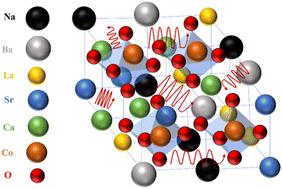当前位置:
X-MOL 学术
›
Phys. Chem. Chem. Phys.
›
论文详情
Our official English website, www.x-mol.net, welcomes your
feedback! (Note: you will need to create a separate account there.)
Thermoelectric behavior of (Ba0.2Sr0.2Ca0.2La0.2Na0.2)CoO3 high entropy cobaltate-based perovskite
Physical Chemistry Chemical Physics ( IF 2.9 ) Pub Date : 2024-11-02 , DOI: 10.1039/d4cp03550j Tathagata Bhattacharya, Ritwik Banerjee, Tanmoy Maiti
Physical Chemistry Chemical Physics ( IF 2.9 ) Pub Date : 2024-11-02 , DOI: 10.1039/d4cp03550j Tathagata Bhattacharya, Ritwik Banerjee, Tanmoy Maiti

|
Oxides are considered as promising thermoelectric materials due to their excellent thermal and chemical stability at elevated temperatures. However, their thermoelectric performances are hindered by high thermal conductivity due to the relatively simple structure compared to the layered or cage-like structure of intermetallics and chalcogenides. In this study, we have successfully crafted a novel cobaltate-based high-entropy oxide perovskite, (Ba0.2Sr0.2Ca0.2La0.2Na0.2)CoO3 (BSCLN), based on detailed thermodynamic calculation. XRD analysis of the as-synthesized ceramics confirms the formation of a cubic perovskite phase, while SEM-EDXS data reveals a dense microstructure with a uniform distribution of all the constituent elements. By employing high-entropy engineering in this cobaltate-based ceramic, we have managed to reduce thermal conductivity significantly while optimizing electrical conductivity. Five different elements populating the A-site induce extensive structural defects and disorder causing enhanced phonon scattering. This results in a glass-like low thermal conductivity of 1.43 W m−1 K−1 at 1023 K for the high-entropy cobaltate. Moreover, we have achieved a comparatively high electrical conductivity on the order of 104 S m−1. This study illustrates the effectiveness of introducing structural disorder through high-entropy engineering to enhance the overall thermoelectric performance of the material.
中文翻译:

(Ba0.2Sr0.2Ca0.2La0.2Na0.2)CoO3 高熵钴酸钙钛矿的热电行为
氧化物被认为是很有前途的热电材料,因为它们在高温下具有出色的热稳定性和化学稳定性。然而,由于与金属间化合物和硫化物的层状或笼状结构相比,它们的热电性能受到高导热性的阻碍,因为其结构相对简单。在这项研究中,我们基于详细的热力学计算,成功地制备了一种新型钴基高熵氧化物钙钛矿,(Ba0.2Sr0.2Ca0.2La0.2Na0.2)CoO3 (BSCLN)。合成陶瓷的 XRD 分析证实了立方钙钛矿相的形成,而 SEM-EDXS 数据揭示了致密的微观结构,所有组成元素分布均匀。通过在这种钴酸盐基陶瓷中采用高熵工程,我们成功地在优化导电性的同时显著降低了导热性。填充 A 位点的 5 种不同元素会诱导广泛的结构缺陷和无序,从而导致声子散射增强。这导致高熵钴酸盐在 1023 K 时具有 1.43 W m-1 K-1 的玻璃状低热导率。此外,我们还实现了 104 S m-1 左右的相对较高的电导率。本研究说明了通过高熵工程引入结构无序以提高材料整体热电性能的有效性。
更新日期:2024-11-02
中文翻译:

(Ba0.2Sr0.2Ca0.2La0.2Na0.2)CoO3 高熵钴酸钙钛矿的热电行为
氧化物被认为是很有前途的热电材料,因为它们在高温下具有出色的热稳定性和化学稳定性。然而,由于与金属间化合物和硫化物的层状或笼状结构相比,它们的热电性能受到高导热性的阻碍,因为其结构相对简单。在这项研究中,我们基于详细的热力学计算,成功地制备了一种新型钴基高熵氧化物钙钛矿,(Ba0.2Sr0.2Ca0.2La0.2Na0.2)CoO3 (BSCLN)。合成陶瓷的 XRD 分析证实了立方钙钛矿相的形成,而 SEM-EDXS 数据揭示了致密的微观结构,所有组成元素分布均匀。通过在这种钴酸盐基陶瓷中采用高熵工程,我们成功地在优化导电性的同时显著降低了导热性。填充 A 位点的 5 种不同元素会诱导广泛的结构缺陷和无序,从而导致声子散射增强。这导致高熵钴酸盐在 1023 K 时具有 1.43 W m-1 K-1 的玻璃状低热导率。此外,我们还实现了 104 S m-1 左右的相对较高的电导率。本研究说明了通过高熵工程引入结构无序以提高材料整体热电性能的有效性。


















































 京公网安备 11010802027423号
京公网安备 11010802027423号